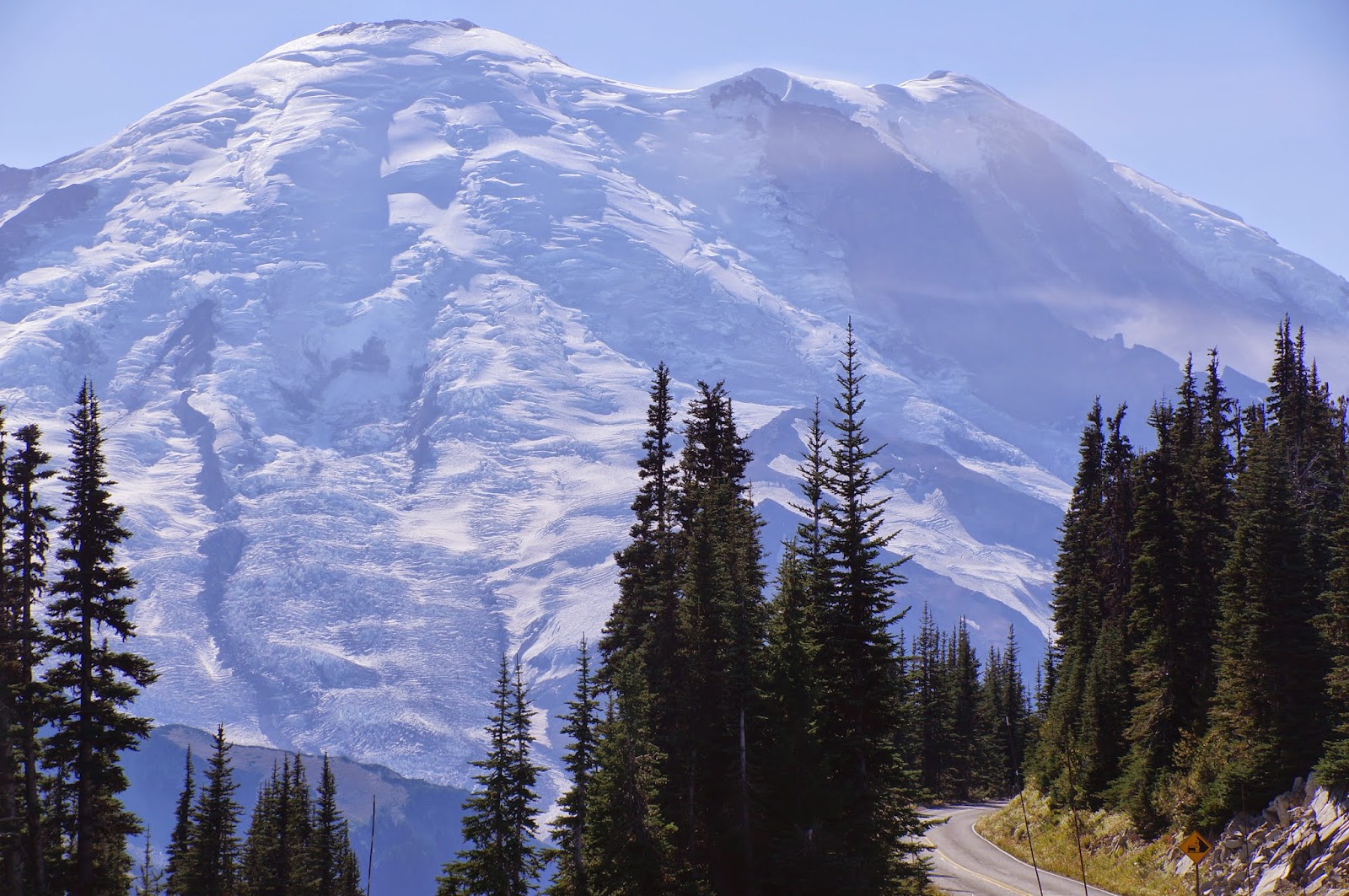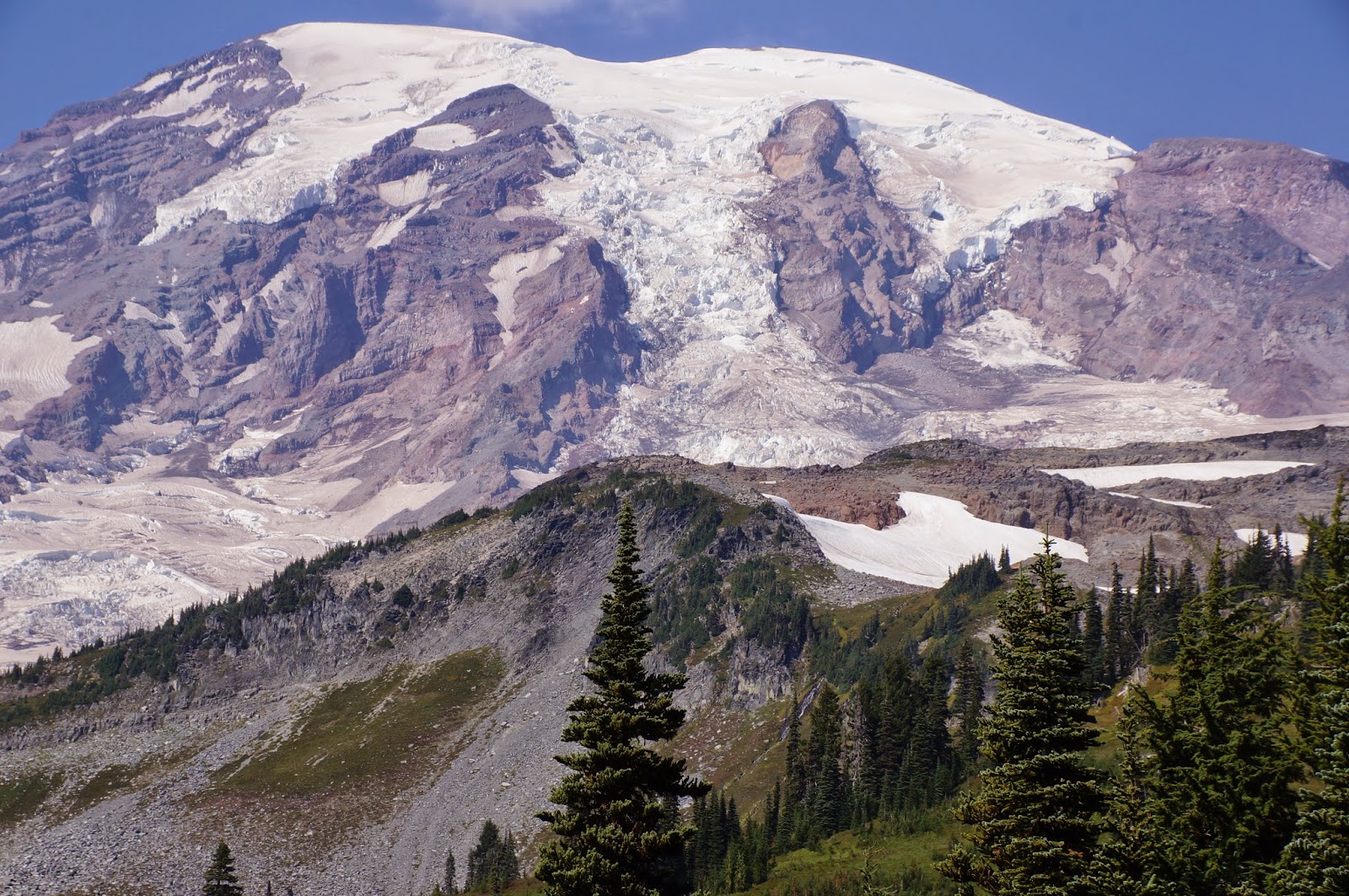SUNDAY
& MONDAY, SEPT 14 & 15:
Two
absolutely beautiful days to explore Mt. Rainier National Park! This is a gorgeous national park. I’m not sure what either of us were expecting, but what we got
surely surpassed any expectations! Staggering
beauty, all the way through.
On Sunday, our main goal was to get
an overview of the Park by driving to Sunrise, the highest point that you can
reach by vehicle in the Park. It’s about
60 miles from the West Entrance, and the road going there traverses a large
portion of the Park. Because of stops we
made along the way and the narrow, twisty, hair-pin curved road, it took us
more than about 4 hours to reach Sunrise.
In this case, it was about both the journey and the
destination. Both were nothing short of
spectacular. The views of Mt. Rainier,
the surrounding peaks of the Cascades, and the absolutely beautiful old growth
forests of Douglas fir, Western cedar, and hemlock made for one of the most magnificent
drives we’ve ever made.
We found out that this gorgeous drive wasn’t by
chance, or luck. Mt. Rainier (our 5th
national park, established in 1899) was our first national park to have a
“master plan” . . . an overall design of the Park that would showcase its
beauty and character to its optimum. So,
for instance, the roads were designed by a landscape architect to both protect
the integrity of the natural beauty and features of the Park, and also to give
visitors the most stunning views possible.
The bridges, tunnels, and guard rails were all made of natural materials
to blend in as much as possible. So were
the buildings. In this way, Mt. Rainier
pioneered the “rustic” style, which came to be the pattern for most of the big
western national parks.
Of
course, the centerpiece is Mt. Rainier herself.
At almost 14,500 feet, it’s by far the tallest peak in the Cascade
range. It’s an active volcano, but currently
“at rest” between eruptive periods. The
last explosion was about 5,500 years ago, and washed down massive amounts of
mud, debris, and rock all the way to Puget Sound. Needless to say, it would be devastating beyond description if another explosion
occurred now, with the current population in the Puget Sound area. Fortunately, scientists are now able to see
signs that the volcano is coming to life again and will be able to give
warnings.
About 25
glaciers cap the mountain, and some are the largest in the lower 48. We saw the familiar evidence of receding
glaciers that we saw so much in Alaska – the braided rivers filled with glacial
silt, the scoured valley walls, the rock-filled valleys, which are being
transformed into verdant meadows.
When we reached Sunrise in the late afternoon,
at 6,400 feet, the views were phenomenal.
Not just close-up views of THE mountain,
but of the other peaks surrounding us.
Took a very short loop trail which led to overlooks of Emmons Glacier, one of largest glaciers on Mt. Rainier, and its glacial river.
We’ve certainly seen grand, majestic mountains before, especially in Alaska, and we’ve seen lots of glaciers up close. But neither of us can remember being so close to such a massive, tall peak . . . so close that we could see different textures of the snow and ice, some of the crevaces, etc. Truly awe-ful.
Christine Falls:
Narada Falls:
The light prism in the falling water:
the mountain vistas, and the dense intense green all around.
And the last extravagance of summer – there were
still some scattered wildflowers. We can
begin to imagine what it must look like when the meadows here are covered with
them. And the voluptuous fragrance of
red cedar accompanying us most of the way!
About
half-way through, we rested at a lovely spot where a little glacier stream
trickled through. Bright green mosses
and islands of bright wildflowers made this place a wonderful oasis of color
amongst the glacial till and the stones and the rock and the ice.
As we approached the high point of the trail, there
was an area where there was snowfall left over from last year, soon to be
dwarfed by much more! This area, around
Paradise, often receives more snowfall than anywhere else in the lower 48 – an
average of 680 inches a year! The lodge is covered u to the 3rd
story windows!
As we climbed even higher,
Bill spotted 2 mountain climbers on a glacier above and ahead of us.
To gain perspective, the guys were climbing on the glacier in the
lower left of Mt. Rainier:
I spotted what we think is
a mountain grouse.
We were both pretty wiped out by the time we reached
the parking lot. In fact, once we
reached the paved last ¼ mile, I took off my hiking boots – that downhill slope
was killing my toes. We collapsed into
the truck, guzzled down some cold drinks, and devoured the leftover sandwiches
we’d had from the other night in Carlton.
But we had enough energy to appreciate John Muir’s sentiment about
Paradise!



















































No comments:
Post a Comment